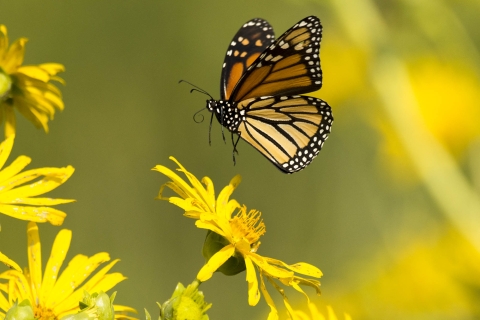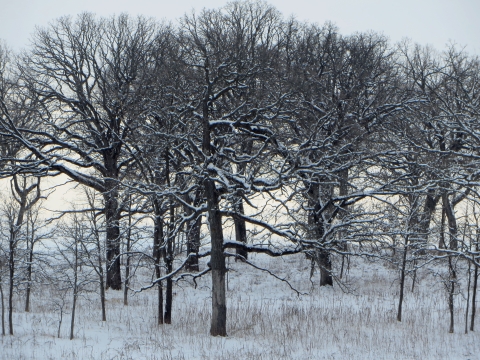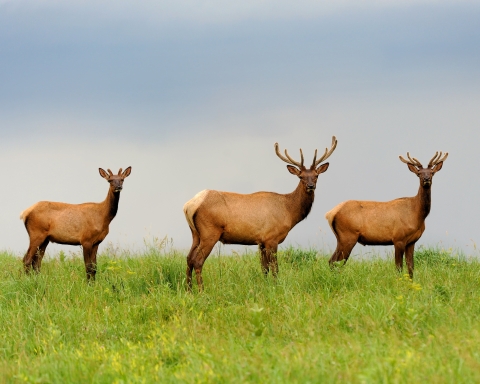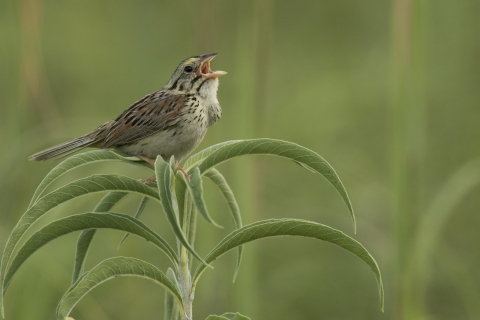Seasons of Wildlife
Spring
In spring, plants begin greening up first in the burned areas. Refuge staff use prescribed fire through much of the spring, depending on weather conditions. In areas that have burned, ant mounds are visible. The first bison calves usually arrive in mid-April. As the days warm, hibernating animals such as thirteen-lined ground squirrels emerge from their underground homes. Birds that have left for the winter return and begin nesting. Early blooming plants like golden Alexander and blue-eyed grass provide the first touches of color to the prairie. Refuge staff plant seedlings in the prairie to increase diversity and improve the health of the prairie.
"The flowers of late winter and early spring occupy places in our hearts well out of proportion to their size." - Gertrude S. Wister
Summer
Summer is a busy time for life on the refuge. Animals and plants take advantage of the warmth and sunshine to grow and reproduce. Week after week, new species of flowers bloom, from purple spiderwort and orange butterfly milkweed to white prairie clover and yellow compass plant. Butterflies, bees and other insects sip the nectar of the abundant flowers. The sky is filled with bird song as males defend their territories. Birds in the prairie and savanna busy themselves with nesting. Bison calves continue to be born and grow. By late summer the bison are in the breeding season, with rutting bulls snorting and fighting.
“In June as many as a dozen species may burst their buds on a single day. No man can heed all of these anniversaries; no man can ignore all of them.” - Aldo Leopold
Fall
As fall begins, many types of plants are still blooming, including many yellow species (sawtooth sunflower, tall coreopsis, several goldenrods). Some don’t begin blooming until well into fall (New England aster, frost aster). Grasses turn color in late summer and fall to shades of purple or rust before curing to tan. Monarch butterflies rely on late-blooming plants as they make their journey south in August, September and October. Monarch migration peaks in September. Summer-blooming plants develop seeds, which are collected by refuge volunteers and staff for spring planting. Fall marks the first frost, when wildlife prepare for winter. Bison and elk grow heavier coats and store fat to keep them warm and nourished through the winter. If you are lucky, you may hear the bull elk bugling to attract females. Nesting migratory birds leave the area for warmer climates. Some birds, such as LeConte’s sparrows, migrate through on their way from their nesting ground to the north to their wintering grounds in the south. Species such as short-eared owls, northern harriers, rough-legged hawks and American tree sparrows that breed to the north of the refuge arrive to spend the winter here. Refuge staff conduct prescribed fire in the fall if weather conditions are right. Staff also conduct the annual bison monitoring event each fall.
"The radio announcers often speak of the fall colors in the hills this time of year, and people drive miles to see them, but I always appreciate the subtle prairie colors too." - Linda Hasselstrom
Winter
Winter is a quiet season. In winter, most life on the refuge goes dormant. Grasses and other plants turn shades of tan. Seed heads of wildflowers may stand out from the grasses. Snow often covers the prairie in mid-winter, and ice occasionally coats the grasses and trees. Some animals take refuge underground, while some move around underneath the snow. After a snowfall, tracks of animals reveal what is still active - rabbits, deer, coyotes and other animals. Winter is a good season to see the elk, which spend much of the summer seeking shade during the daytime. Winter is the best time to see short-eared owls on the refuge. They can often be seen flying near the roads in the early morning and late afternoon.
"I prefer winter and fall, when you feel the bone structure in the landscape - the loneliness of it - the dead feeling of winter. Something waits beneath it - the whole story doesn't show." - Andrew Wyeth
Featured Species
Bison
Bison once numbered in the millions and roamed great distances across the prairies. These large herds had a huge impact on the prairie ecosystem. By the early 1900s, habitat loss and unregulated hunting nearly drove the population to extinction. Neal Smith National Wildlife Refuge has a small herd of bison in an 800 acre enclosure that helps shape the tallgrass prairie ecosystem; they can sometimes be seen from your vehicle on the auto tour route as well as from the Tallgrass and Overlook Trails and the visitor center. Bison calves are born between April and August. Bison are attracted to areas that have been recently burned, where fresh green sprouts provide a protein-rich food source. At the refuge, the bison are being managed to maintain genetic diversity and a healthy herd.
Elk
Elk were once common in the tallgrass prairie of Iowa. Elk are here to replay the role they historically had in this ecosystem. Elk share the 800 acre fenced area with bison. The elk eat grasses, wildflowers and woody plants. Often secretive, they are best seen late fall through early spring when the prairie is dormant and shorter. During the summer and when it is warmer, they are easier to spot during the cooler times of the day. Management of elk primarily consists of monitoring their health and controlling the population size.
Grassland Birds
Prairies are important habitat for a diversity of grassland birds. Many species of grassland birds have been declining throughout the continent since prairies were first plowed. Some species that use Neal Smith National Wildlife Refuge for nesting include upland sandpiper, sedge wren, Henslow’s and grasshopper sparrow, common yellowthroat, dickcissel, eastern and western meadowlark and bobolink. During spring and fall migration, the refuge also hosts clay-colored, LeConte’s and savanna sparrows and Smith’s and Lapland longspurs. During the winter, American tree sparrows are abundant. Northern harriers and short-eared owls are present during migration and in winter.








